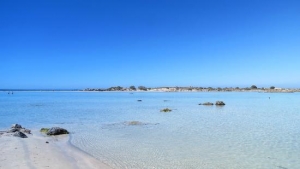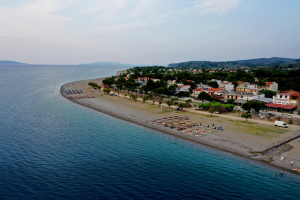XpatAthens
Aegean Air Adds 10 More Countries To Its Routes
Aegean Airlines announced on Tuesday it is adding 16 new destinations in 10 new countries to its network next summer, reaching a total of 134 destinations, 34 domestic and 100 abroad in 42 countries.
The airline’s network will as of next year add Helsinki in Finland, Toulouse, Deauville and Metz in France, Naples and Pisa in Italy, Malta, Kuwait, Amsterdam in the Netherlands, Paphos in Cyprus, Riyadh in Saudi Arabia, Tallinn in Estonia, Oslo in Norway, Tehran in Iran, Dubrovnik in Croatia and Yerevan in Armenia.
Aegean will also increase its flights from major markets for Greek tourism such as Britain, Germany, Switzerland, France and Italy, and to popular island destinations such as Naxos, Milos and Paros.
The 2015 schedule of Greece’s main carrier will offer 15 million seats, up 2 million from 2014, as its summer schedule has evolved into a stronger one than initially planned, with more new destinations, given that the growth prospects of the company appear particularly positive.
To read more, please visit ekathimerini.com
By Alexandra Kassimi
Kataifi Yanniotiko - Nut-Stuffed Shredded Wheat Rolls
Most people who are familiar with kataifi, the thin-strand pastry, think it is actually shredded wheat or shredded phyllo. In fact, it’s made with a batter that is poured through a tiny-holed spout onto a large, hot, circle griddle that spins slowly, thus creating the vermicell-like effect. There are still a few places that still make this by hand here in Athens, if you’re willing to do some research and looking around...
8-12 servings
¾ pound/340 g. unsalted butter
½ pound/225 g. blanched almonds or walnuts, coarsely chopped
½ cup ground rusks
1 tsp. grated orange rind
1 tsp. ground cinnamon
2-3 Tbsp. granulated sugar
1 pound/450 g. kataifi/shredded wheat pastry
½ pound/225 g. thin commercial phyllo pastry
For the Syrup
4 cups sugar
5 cups/1.2 litters water
2 tsp. strained fresh lemon juice
1. Clarify butter: Place butter in a small saucepan and heat slowly over low heat. Remove pan from heat and cool for 2 to 3 minutes. With a spoon, skim the milky foam from the top of the butter and discard foam. Pour the remaining clarified butter in a bowl and set aside until ready to use.
2. Preheat oven to 180˚C. Lightly butter a 22x30x8 cm baking pan.
3. In a medium-size bowl. Stir together nuts, ground rusks, orange rind, cinnamon, and sugar and set aside until ready to use.
4. Unwrap the kataifi pastry and the phyllo and divide each in half. Keep both covered so they will not dry out. Layer half the phyllo pastry, 1 sheet at a time, on bottom of prepared baking pan, brushing each sheet generously with clarified butter. Spread half the kataifi pastry over the phyllo and brush with butter. Spread the nut mixture over the kataifi and dot with butter. Cover nuts with remaining kataifi and brush again with butter. Layer remaining phyllo over kataifi, brushing each layer generously with butter. Tuck the phyllo neatly into the sides of the pan. Pour remaining butter over phyllo. Score lightly –1.8 to 2.5 cm deep – at first vertically, then horizontally, to form diamonds. Bake for about 1 hour 10 minutes, or until phyllo is golden brown.
5. To prepare syrup: While the pastry is baking, in a medium-size saucepan, combine sugar and water and bring to a boil. Simmer, uncovered, over low to medium heat for 15 minutes. Add lemon juice and remove pan from heat.
6. When pastry is done, remove baking pan from oven and spoon warm syrup over the pastry. Cool pastry in pan before serving.
By Diane Kochilas
VC Money Pours Into Greek Start-Ups
"The crisis has pushed people into survival mode, and they are looking for opportunities," according to Stavros Messinis, CEO and founder of The Cube, a start-up incubator in Athens. "At this point, there isn't much for them to lose."
Most are tired of an unstable political system unable to put the country back on its feet. Since the start of the economic crisis in 2009, Greece has lost more than 25 percent of its GDP, and thousands of enterprises have gone bust under the pressure of a deepening recession. This summer the country defaulted on more than $280 billion of debt, and capital controls were issued to prevent a run on the banks.
As Messinis explained, "Up until now, 70 percent of Greeks were employed by the public sector. But that is now crumbling. Now we need to develop a high-tech sector that can produce value-added products and services to turn the economy around."
Elafonissi In Crete Voted 2nd Best Beach In Europe
Top Things To Do In Athens
Some of the best spots for local brews, grain bowls, flea markets, brunches, fine delicatessens, and beard balms can be found in downtown Athens, around the streets of the Parthenon, known as the historical triangle.
Born in Athens, designer Christina Economou, takes us on a tour of her favorite places and describes what makes a perfect day.
Starting the day early with coffee, Economou then takes a morning walk through the National Garden, a beautiful place filled with inspiration for a designer.
Additional Bakeries and Cafes
Takis Bakery: Open since the 1970’s, this family-run bakery serves delicious Greek and international breads, cakes, and pies. Popular sweets include a lemon drizzle pound cake, carrot cake, or the double-decker daily special.
Lotte Café-Bistrot: An adorable anachronistic café situated to the east of the Acropolis, was started as a side project by the owner, Theodora Athanasopoulou, about a year and half ago. This café is a gathering for the Athenian creative class, who like to drink organic Greek wine and signature cocktails while eating Greek pies, cakes, and homemade sweets that are made by Theodora’s mother.
Before heading to work, Economou stops at the sea market of Plateia Avissinias, which has anything from vintage chairs to a tiny curiosity box.
A nice place to eat lunch, according to Economou, is at the Cycladic Museum or a restaurant called Alfiere, that serves sandwiches with truffles. If you’re craving Italian food, Capanna has a great lunch menu.
At the end of the work day, Economou meets with friends for an evening dinner and drinks at RATKA or Freud in Kolonaki, a place for sushi and a great atmosphere. If dinner is not on the agenda, Economou will try to catch an interesting exhibit at the Gagosian Gallery or the Benaki Museum.
If Economou feels like more drinks and dancing, she will head to Cinderella, a new discotheque, or Jazz in Jazz, a small bar close to home.
Additional Bars and Clubs
Alexandrino in Exarchia: A chic place, perfect for unwinding with a glass of wine.
Kitty Cat: What was once an old Chinese restaurant, it is now a nightclub with a hipster vibe and a great place to have drinks and dance until 4 in the morning!
Barrett: On the border of the Monastiraki flea market and Psyri, Barrett is a new alternative rock bar. There are different DJ’s every night and the crowd is filled with artists and musicians. The drinks are affordable and they have a great selection of beers and music. There is also a gallery upstairs with new exhibits every month or two.
Couleur Locale: With multiple levels serving different things, the 3rd floor has a great night scene. It is open air, has stunning views, and an extensive cocktail menu.
Top Spots for Shopping
Greece Is For Lovers: Offers attractive contemporary products with a signature aesthetic, combining kitsch and luxe. Many of their pieces are one-of-a-kind, designed by local craftsmen, Thanos Karampatsos and Christina Kotsilelou.
Forget Me Not: A gift shop in the heart of Plaka, which features products an designs from more than 150 Greek artists, architects, and graphic designers.
Iliana Makri: Offers local, handmade pieces as well as international and Greek jewelry designs.
Luisa: Great for high-end designer clothes.
Attica: One of the best department stores and carries Economou’s collection.
For more suggestions on Top Things To Do In Athens, please visit: Harper's Bazaar and Vogue
Unique Wines Of Greece To Try
World’s Top Swimmers Petar Stoychev & Yasunari Hirai At The Authentic Marathon Swim
The historic race The Authentic Marathon Swim revives at Artemision 2,500 years later. The interest of swimmers from all over the world, to participate in the authentic marathon swimming route and other swimming activities, is gradually peaking, as the date of the great sporting event approaches, occurring on September 4-6, 2020, at Pefki, Evia, of the Municipality of Istiaia - Edipsos.
World-class athletes will be present eagerly
The number of participating swimmers listed among the elite of marathon swimming is enriched with major names on a daily basis. Further to the confirmation of the first two hall of famers, the silver Olympic medalist Spyros Gianniotis and the Hungarian swimmer Attila Manyoki, the swimming Olympic champion Petar Stoychev is the third consecutive hall of famer to confirm that he will be taking part in The Authentic Marathon Swim. The Bulgarian champion has participated in 4 Olympics, has 11 consecutive titles in major international open water marathon swimming FINA series and holds the impressive achievement of being in the Ice Swimming Hall of Fame. The race will also be honored with the participation of the Japanese Olympic champion in Rio, Yasunari Hirai. Top names from Greece will also take part in The Authentic Marathon Swim. Specifically, the open water masters’ world champion, Vicky Kouveli and the bronze medalist in 2011 world open water swimming championship, with 4 participations in Olympics and 37 gold Greek championships, Marianna Lymperta will also compete in the event, together of course with the elite of the Greek national open water swimming team.
In the afternoon of Saturday, September 5, the action will begin with the 3km and 1.5km open water swimming races. Respectively, on the morning of Sunday, September 6, the event will culminate with the revival of the authentic 10km marathon swimming route, while at the same time the 800m children’s race will be taking place. All swimming routes will be executed with absolute safety at Pefki, Evia, of the Municipality of Istiaia - Edipsos. The Authentic Marathon Swim will be held with the approval of the Hellenic Swimming Federation, according to FINA regulations.
Accommodation packages & offers at the Municipality of Istiaia-Edipsos
The Authentic Marathon Swim already collaborates with more than 30 hotels in the region, with the aim of revitalizing the sports tourism industry of Northern Evia and strengthening the Greek tourism product. Up to this point, this year’s event is enormously supported with special offers and prices starting from 40 euros, by the following hospitality sponsors: Maria Louiza Apartments, Hotel 40 Platania, Altamar Hotel, Ellaeon Throesma, Artemision Hotel, Galini Hotel Edipsos, Ilios Studios, Villa Anastasia, Κochili Apartments, Hydna Studios, Island, Irene Studios, Aidipsos Hotel, Aktaion Hotel, Aenaon Studios, Alex Spa Hotel, Anesis Pefki, Artemis Rooms Pefki, Arethousa Hotel, Avli Hotel, Dimitra Apartments, Ermis Spa Hotel, Evia Dream, Galini Hotel Pefki, Kallithea Hotel, Katerina Apartments, Lito Hotel, Mitho Hotel, Jenny Studios, Papadioti Αpartments, Rodon Hotel, Drosia Studios, Garden Studios Pefki.
Participants and visitors can take advantage of the special offers, providing reduced accommodation prices and late check out while discovering beautiful hotels in the areas of Pefki, Loutra Edipsos, Artemision, Istiaia, Kanatadika, Neos Pyrgos, Orei and Agiokampos.
Discover accommodation packages & special offers!
Photo Credit: Municipality of Istiaia-Edipsos
Website
Facebook Page
Instagram Page
Twitter Account
YouTube Channel
A Season Of Traditions
Athens Mayor Presents New Lykavittos Theater in Timelapse Video
To read this article in full, please visit news.gtp.gr
Live & Work Remotely In Greece: Digital Nomad Residence Permit
If your dream is to answer emails from a seaside café or take Zoom calls with a view of the Aegean, Greece’s Digital Nomad Residence Permit might be the key to unlocking your ideal work-life balance.
What Is the Digital Nomad Residence Permit?
- Employment Status: You must be either self-employed or employed by a non-Greek company.
- Income: A minimum monthly income of €3,500 is required, with higher thresholds for dependents.
- Documentation: Necessary documentation includes a valid entry visa or eligibility for a visa exemption, a full medical care certificate, and a residential lease or property purchase contract.
- Supporting Documents: Additional Documents: The amount of sufficient resources is evidenced: a) by the employment contract or project contract or proof of employment relationship, in the case of dependent labor, services, or project, and b) Statements from your bank
- Translation: All non-Greek documents must be translated as required.
- Family Members: You can bring your spouse and children, provided you submit the necessary marriage and birth certificates.
Validity: 2 years, renewable electronically
Fees: €1,000 admin fee
Application: Handled by the One-Stop Service of the Ministry of Migration and Asylum
Need help managing the paperwork? Let Expat Law’s digital nomad visa specialists handle the process for you—from translations to legal representation. No in-person appointments required.
B. Digital Nomad Visa
Validity: Up to 12 months
Application: Submit through a Greek consulate in your home country
Fees: €75 visa fee + €150 admin charge
Limitations: Renewal requires exiting and reapplying—less flexible than the residence permit
Why Choose Greece as Your Remote Work Base?
- Affordable living costs
- High-speed internet in most urban centers
- Warm climate and natural beauty
- Access to EU-standard healthcare
- Vibrant international communities in cities like Athens, Thessaloniki, and Chania
- Double-check translations: Greek bureaucracy is strict about official documentation.
- Secure housing early: A signed lease or property ownership is required.
- Start early: Processing times vary and legal support can help prevent delays.
- Work with professionals: The laws evolve, and having experts on your side makes the journey smoother.














